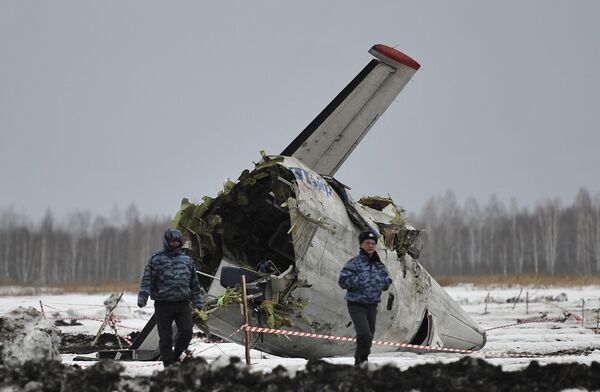Russian airline UTair suspended flights by its two remaining ATR 72-200 aircraft until the end of an investigation into Monday’s deadly plane crash, as pilots and air safety experts focused on airframe icing as a likely factor in the crash.
“There are no doubts about the plane's airworthiness as of today," UTair Director General said after the decision to ground the planes. "The decision was made from a psychological standpoint,” he said.
The turboprop ATR 72 aircraft crashed some two miles from Tyumen’s Roshchino Airport while trying to make an emergency landing in the early hours of Monday. Thirty-one people died, including the entire crew, and twelve other passengers remain hospitalized with serious injuries.
Transport authorities had said on Monday there were no grounds to suspend ATR 72 flights.
The Interstate Aviation Committee said on Tuesday that after takeoff the aircraft climbed to an altitude of some 210 meters, after which it first banked 35 degrees to the right and then to the left reaching over 50 degrees by the time it hit the ground.
The steep bank which the aircraft made shortly after take off may have been induced by icing on the aircraft’s tailplane or an unsynchronized retraction of its flaps, a Russian pilot told RIA Novosti at a roundtable discussion on Tuesday.
“This acute bank could not have been caused simply by an imbalance of the aircraft,” said former pilot Mikhail Markov.
Flap retraction normally takes place at a height of 220 meters, the height at which the aircraft appeared to start going out of control, he said.
“This bank would exceed the permitted bank produced by the aircraft’s control surfaces, which is limited to 15 degrees. Ice on the tailplane could form during the short time spent taxying, and it might not be enough to scare you into canceling a flight, but could have a fatal effect,” he said.
MAK also said that the aircraft’s engines were operating normally until impact, but Markov said this did not mean that they could be ruled out as a contributing factor, as the pitch of the propeller blades was just as important.
“The engines were working, but that might not mean anything. The powerplant is not just the engine, but the propeller too, which might not have been in the right position. What position the propeller was set to is not clear. There could have been an imbalance caused by differential power from the engines or propeller thrust,” as a result of icing he said.
Icing could have come about due to the pilot’s declining to have the aircraft deiced properly, the Russian Air Transport Authority’s Alexander Neradko said on Monday. Local airport officials also confirmed that the aircraft had not been deiced, following a decision by the captain.
Icing can take place in a temperature band from minus 12 to plus 4 Celsius, Markov said. The temperature at Tyumen was around 0.6 degrees Celsius when the aircraft took off on Monday morning.
MAK took panoramic photos of the crash scene on Tuesday as part of the crash investigation.




